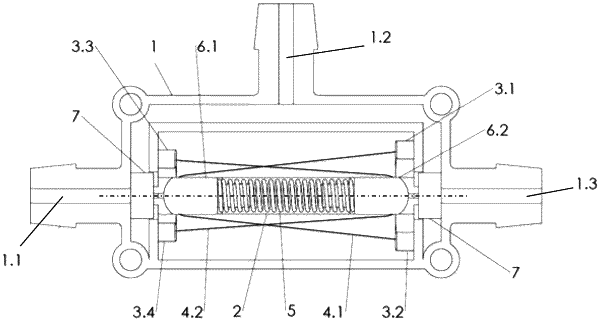| CPC F16K 31/025 (2013.01) [F16K 11/22 (2013.01); F16K 11/24 (2013.01)] | 13 Claims |

|
1. A valve for controlling one or more fluids, comprising:
a housing (1) having at least a first opening (1.1), a second opening (1.2), and a third opening (1.3);
a first actuating element (6.1) and a second actuating element (6.2) that are each movable along a common longitudinal axis along a guide of the housing (1);
a return element (5) arranged between the first actuating element (6.1) and the second actuating element (6.2), the return element (5) exerting a force and keeps the first actuating element (6.1) and the second actuating element (6.2) in a rest position in which the first actuating element (6.1) closes or opens the first opening (1.1) and the second actuating element (6.2) closes or opens the third opening (1.3);
a first wire (4.1) formed with or from a shape memory alloy and being arranged on the first actuating element (6.1) and on a part of the housing (1) opposite the first actuating element (6.1); and
a second wire (4.2) formed with or from a shape memory alloy and being arranged on the second actuating element (6.2) and on a part of the housing (1) opposite the second actuating element (6.2);
wherein an electric current applied to the respective first or second wire (4.1, 4.2) results in a contraction of the respective wire (4.1, 4.2), so that the corresponding actuating element (6.1, 6.2) is movable from the rest position into an activated position against the force exerted by the return element (5).
|